您现在的位置是: 首页 > 教育改革 教育改革
2021高考非谓语动词学科网_2013高考非谓语动词
tamoadmin 2024-05-15 人已围观
简介1.什么是非谓语动词,怎么用?一、非谓语动词的概念 非谓语动词是指动词不定式、动名词和分词。 它们是动词的非限定形式。 在句子中它们起着一些特殊的作用。 以下简要介绍它们各自的构成、作用及应用。 二、动词不定式 不定式是指带to的动词原形(使用中有时不带to), 在句中起形容词或副词的作用, 可以作状语和定语。 (一)作定语 1. 动词不定式与其修的词之间往往有动宾关系, 如果该不定式是不及物动词
1.什么是非谓语动词,怎么用?

一、非谓语动词的概念
非谓语动词是指动词不定式、动名词和分词。
它们是动词的非限定形式。
在句子中它们起着一些特殊的作用。
以下简要介绍它们各自的构成、作用及应用。
二、动词不定式
不定式是指带to的动词原形(使用中有时不带to),
在句中起形容词或副词的作用, 可以作状语和定语。
(一)作定语
1. 动词不定式与其修的词之间往往有动宾关系,
如果该不定式是不及物动词, 其后有必要的介词。
He's pleasant fellow to work with.
There's nothing to worry about.
2. 有些名词后常跟不定式作定语。例如: time, reason, chance,
right, ability, willingness, need, anxiety, wish, plan等。
Women should have the right to receive education.
There is no time to hesitate.
3. the first, the second, the last, the best 等之后用不定式做定语。
The monitor will be the first to come.
He was the last man to blame.
(二)作状语
1. 作目的状语
不定式作状语时, 其动作发生在谓语动词之后, 一般置于句子末尾。
但是, 如果表示强调, 亦可置于句首。
其否定形式为: 在不定式符号前加not。
He went to Shanghai to visit his parents.
To save the earth, we must prevent the earth from being polluted.
I shut the door quietly, so as not to wake the baby.
2. 作结果状语
We came home after our holiday to find our garden neat and tidy.
She left home, never to return again.
3. 作原因状语
不定式做原因状语时, 一般放在句子末尾。
She burst into laughter to see his funny action.
The boy was shocked to see the frightening scene.
4. 作独立成分
有些固定词组带to不定式, 表明说话人的立场或态度, 在句中作独立成分。
这些词有:
to be honest, to begin with, to cut a long story short,
to get (back) to the point, not to make much of it,
to put it another way, to tell the truth等。
To tell you the truth, I have never been to Beijing.
To be honest, I have never heard of Winston Churchill.
三、动名词
动名词也是动词的一种非限定形式, 由动词原形加词尾-ing构成。
与现在分词构成法相同。它同时具有动词及名词特征。
以下主要介绍其做定语及状语的情况。
1. 作定语
None is allowed to smoke in the waiting room.
The speeding car came to a stop all of a sudden.
2. 作状语
介词+动名词可以作状语用, 表示时间、原因、目的、让步、方式等。
After finishing the job, he went home.
He was blamed for having done something wrong.
They went to Manchester with the object of winning the World Championship.
四、分词
分词是动词的三种非限定形式之一, 包括现在分词和过去分词两种。
分词可以在句中作状语及定语。
(一)现在分词与过去分词的区别
现舂词与过去分词的区别主要表现在语态和时间概念上。
在语态上,现在分词(除被动式外)表示主动意思, 过去分词表示被动意思。
在时间上, 现在分词表示动作正在进行, 过去分词则表示动作已完成。
developing countries(发展中国家)
developed countries(发达国家)
the touching tale(动人的传说)
the touched audince(受感动的观众)
(二)现在分词的用法
现在分词可在句中作定语和状语。
1. 作定语
现在分词作定语时多置于它所修饰的名词前:
This is a pressing question.
这是一个紧迫的问题。
He asked an embarrassing question.
他提了一个令人难堪的问题。
现在分词亦可置于它所修饰的名词之后:
There were no soldiers drilling.
现在分词短语一般皆置于其修饰的名词之后:
A little child learning to walk often falls.
The men working here are all from the rural areas.
2. 现在分词用作状语
现在分词及其短语从表意的角度看, 也可用作状语, 表示时间、原因、
结果、条件、让步、方式或伴随情况等。
其动作可能发生在谓语动词之前或之后, 也可能与谓语动的动作同时发生。
(1)表示时间
Climbing to the top of the tower, we saw a magnificent view.
He went out shutting the door behind him.
强调与谓语动词的动作同时发生时, 现在分词之前可用连词when或while:
When leaving the airport, they waved again and agin to us.
While flying over the Channel, the pilot saw what he thought
to be a meteorite.
(2)表示原因
Being sick, I stayed at home.
She caught cold sitting on the grass.
(3)表示条件
Adopting this method, we will raise the average yield by 40 percent.
Turning to the right, you will find a path leading to his cottage.
(4)表示让步
Admitting what she has said, I still think that she hasn't tried her best.
(5)表示结果
It rained heavily, causing severe flooding in that country.
It rained for two weeks on end, completely ruining our holday.
(6)表示方式或伴随情况
He ran up to her breathing heavily.
Please fill in the form, giving your name, address, etc.
或者可以去看看这个
http://baike.baidu.com/view/79702.htm
非谓语动词
开放分类: 英语、语法
什么是非谓语动词,怎么用?
高考英语非谓语动词巧记巧用
一、接不定式和接动名词意义不同的动词和短语
在下列8个动词和短语动词后接不定式和接动名词意义不同:
remember to do(记住去做) remember doing(记得做过)
forget to do(忘记去做) forget doing(忘记做过)
regret to do (遗憾地做) regret doing(后悔做了)
try to do(设法做) try doing(试做)
go on to do(接着做另一事) go on doing(继续做同一事)
mean to do(打算做) mean doing(意味着)
stop to do(停下来去做) stop doing(停止做)
can’t help to do(不能帮助做) can’t help doing(情不自禁做)
1. —You were brave enough to raise objection at the meeting.
—Well, now I regret ________ that. (全国卷)
A. to do B. to be doing
C. to have done D. having done
分析答案选D。由语境可知“我”“后悔”在会上提出异议,应接动名词。
2. —The light in the office is still on.
—Oh,I forgot ________. (全国卷)
A. turning it off B. turn it off
C. to turn it off D. having turned it off
分析答案选C。表示忘记做某事,事情还没做,forget后接不定式。
3. In some parts of London, missing a bus means ________ for another hour. (上海卷)
A. waiting B. to wait
C. wait D. to be waiting
分析答案选A。由语境可知句中的mean表示“意味着”,后接不定式。
4. She reached the top of the hill and stopped ________ on a big rock by the side of the path. (全国卷)
A. to have rested B. resting
C. to rest D. rest
分析答案选C。休息是停下来的目的,且发生在stop之后,用接不定式的一般式。
5. Go on ________ the other exercise after you have finished this one. (全国卷)
A. to do B. doing
C. with D. to be doing
分析答案选A。表示做完一事后“接着做”另一事,go on后接不定式。
二、表示未成实现的愿望或打算的动词和短语
表示未曾实现的愿望或打算,即表示“本打算 / 想 / 希望做某事”但事实上却没做的事情,用plan, intend, mean; want, hope, wish, expect等动词的过去完成时,加不定式的一般式,或者这类动词的一般过去时,加不定式的完成式;was / were, would / should like加不定式的完成式;was / were going加不定式的一般式。如:
I would love ________ to the party last night but I had to work extra hours to finish a report. (全国卷)
A. to go B. to have gone
C. going D. having gone
分析答案选B。由句意可知,是表示过去未曾实现的期望,用“would love+不定式完成式”。句意是:昨晚我本想去参加聚会的,但是…(from www.nmet168.com)
三、要接动名词的含有介词的常用句型
在介词后一般用动名词,下面是一些含介词的固定句式(其中有的介词有时会被省略):prevent / stop / keep sb. / sth. from doing (阻止…做…);spend / waste time or money in doing (在做…方面花费 / 浪费时间或金钱);How / What about doing sth. (做…怎么样?);have some difficulty / trouble in doing (在做…方面有些困难);have a hard time in doing sth. (做某事很艰难); there is no sense in doing(做…是没有理由 / 道理的);thank (excuse / admire / praise / blame / scold / punish) sb. for doing sth. (因做某事而感谢 / 羡慕 / 表扬 / 责备某人)等。如:
1. Having been ill in bed for nearly a month, he had a hard time ________ the exam. (福建卷)
A. pass B. to pass
C. passed D. passing
分析答案选D。因为have a hard time (in) doing sth. 在做某事方面有困难。
2. According to a recent U. S. survey, children spend up to 25 hours a week ________ TV. (上海卷)
A. to watch B. to watching
C. watching D. watch
分析答案选C。spend some time (in) doing sth. 做某事花了多长时间。
3. I believe that’s the best way to prevent such a thing ________ again. (全国卷)
A. to happen B. from happening
C. happened D. happen
分析答案选B。prevent sb. / sth. from doing 阻止…做…。
4. Did you have trouble ________ the post office? (全国卷)
A. to have found B. with finding
C. to find D. in finding
分析答案选D。have difficulty / trouble (in) doing sth. 在做方面有困难。
四、to是介词的常用固定结构
to是介词和固定词组很多,常见的有:look forward to(盼望), devote…to / be devoted to(致力于), be / get used to(习惯), lead to(导致), get down to(开始认真), pay attention to(注意), refer to(谈到), point to(指向), turn to(转向), object to(反对), equal to(等于、能胜任), belong to(属于)等。如:
1. Mr. Reed made up his mind to devote all he had to ________ some schools for poor children. (上海卷)
A. set up B. setting up
C. have set up D. having set up
分析答案选B。devote…to…中to是介词,接动名词;all是devote的宾语,he had是省略了关系代词that的定语从句。
2. The discovery of new evidence led to ________. (上海卷)
A. the thief having caught B. catch the thief
C. the thief being caught D. the thief to be caught
分析答案选C。lead to中的to是介词,后接动名词;逻辑主语the thief与catch是被动关系,所以用动名词的被动式(from www.nmet168.com)。
3. She looks forward every spring to ________ the flower-lined garden. (上海卷)
A. visit B. paying a visit
C. walk in D. walking in
分析答案选D。look forward to中to是介词,后接动名词。再说,若visit用作名词,后面要加介词to,才可接宾语,排除A和B;walk作名词,表示散步,仅用于go for / take / have a walk等结构,排除C。
非谓语动词指在句中不作谓语的动词。在句中充作状语、定语、宾语宾语补足语、表语。一般包括不定式、进行式和过去分词。
不定式的
一般式 to do
被动式 to be done
进行式的
一般式 doing
完成式 having done
过去分词 done
非谓语动词有很多变化。应该对你有帮助8~









